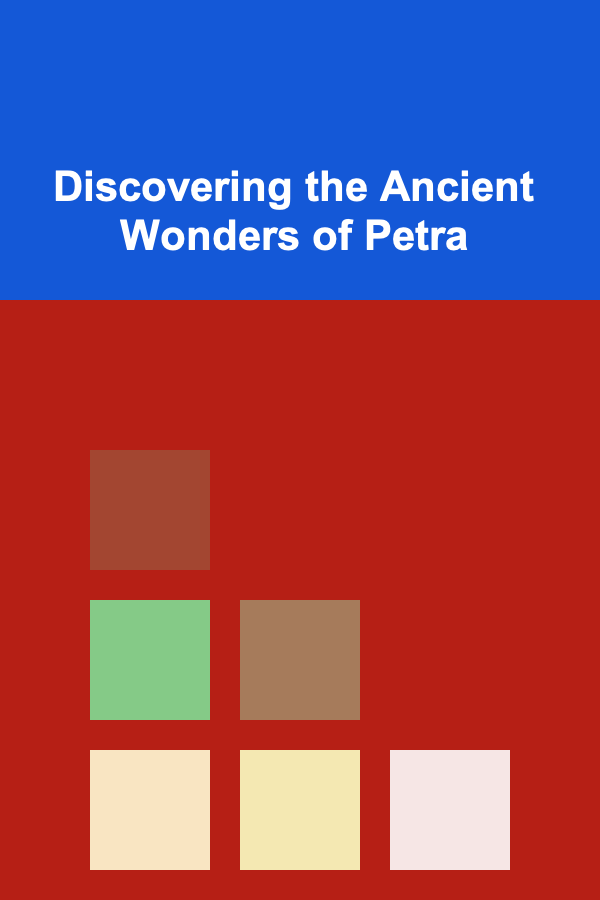
Discovering the Ancient Wonders of Petra
ebook include PDF & Audio bundle (Micro Guide)
$12.99$11.99
Limited Time Offer! Order within the next:

Petra, the "Lost City," carved into the sandstone cliffs of southwestern Jordan, is more than just a breathtaking sight; it's a testament to human ingenuity, resilience, and artistry. Exploring Petra is an immersive journey through history, offering a glimpse into the sophisticated Nabataean civilization that thrived here for centuries. This in-depth guide will provide you with the essential information and insights you need to plan a truly unforgettable visit to this UNESCO World Heritage site.
Planning Your Trip: Preparation is Key
Before embarking on your Petra adventure, meticulous planning is crucial. Consider the following factors to ensure a smooth and rewarding experience:
Best Time to Visit
The optimal time to visit Petra is during the shoulder seasons: spring (March-May) and autumn (September-November). During these months, the weather is generally pleasant, with warm days and cool evenings. Avoid the intense heat of the summer months (June-August), where temperatures can soar above 40°C (104°F), making exploration challenging and potentially dangerous. Winter (December-February) can be chilly, with occasional rain and even snow, especially at higher altitudes. However, winter offers a unique and less crowded experience.
Obtaining a Visa
Most nationalities require a visa to enter Jordan. You can typically obtain a visa upon arrival at Queen Alia International Airport in Amman or at the land border crossings. Alternatively, you can apply for a visa in advance through the Jordanian embassy or consulate in your country. Consider purchasing the Jordan Pass, which includes visa fees (if staying for at least three nights) and entry to numerous historical sites, including Petra. This can save you considerable time and money.
Accommodation Options
Wadi Musa, the town closest to Petra, offers a wide range of accommodation options to suit all budgets. From luxury hotels with stunning views to budget-friendly guesthouses, you'll find something to fit your needs. Booking in advance, especially during peak season, is highly recommended. Consider staying for at least two nights to fully explore the vast site of Petra.
What to Pack
Packing appropriately is essential for a comfortable and safe visit to Petra. Here's a checklist:
- Comfortable walking shoes: You'll be doing a lot of walking on uneven terrain, so sturdy and supportive footwear is a must.
- Sunscreen: The Jordanian sun can be intense, even during the shoulder seasons.
- Hat and sunglasses: Protect yourself from the sun's glare and heat.
- Lightweight, breathable clothing: Opt for loose-fitting clothes that will keep you cool in the heat.
- Water bottle: Stay hydrated by carrying a reusable water bottle and refilling it whenever possible.
- Snacks: Pack some energy bars or other snacks to keep you going between meals.
- First-aid kit: Include essentials like bandages, antiseptic wipes, and pain relievers.
- Cash: While some establishments accept credit cards, it's always a good idea to have cash on hand, especially for smaller vendors and tips.
Tip: Consider bringing a scarf or keffiyeh to protect your face and neck from the sun and dust. You can purchase one locally, which can also serve as a souvenir.
Entering Petra: The Siq and Beyond
The journey into Petra begins with a walk through the Siq, a narrow gorge that winds for over a kilometer. This natural chasm, formed by tectonic forces and sculpted by water erosion, is an awe-inspiring introduction to the city. As you traverse the Siq, pay attention to the subtle details:
- Nabataean water channels: Carved into the rock walls, these channels demonstrate the Nabataeans' ingenious engineering skills. They collected rainwater and channeled it into the city for drinking and irrigation.
- Remains of ancient pavements: Look closely at the ground to see remnants of the original paved road.
- Erosion patterns: Observe the intricate patterns carved into the sandstone by wind and water over millennia.
The Treasury (Al-Khazneh)
The dramatic culmination of the Siq is the Treasury (Al-Khazneh), Petra's most iconic monument. Carved directly into the sandstone cliff face, this majestic facade is a masterpiece of Nabataean architecture. Its intricate details, including statues of deities and mythological figures, are remarkably well-preserved.
The Treasury's exact purpose remains a mystery. While its name suggests it was used to store treasure, historians believe it may have been a royal tomb or a temple. Regardless of its function, the Treasury is an unforgettable sight that embodies the grandeur of Petra.
Image of The Treasury (Al-Khazneh)
Tip: Arrive at the Treasury early in the morning to avoid the crowds and capture the best light for photographs. Alternatively, visit in the late afternoon when the setting sun casts a warm glow on the facade.
The Street of Facades
Beyond the Treasury, the Siq opens into the Street of Facades, lined with a series of monumental tombs carved into the rock faces. These tombs represent a variety of architectural styles, reflecting the Nabataeans' diverse cultural influences. Notice the variations in design and decoration, which provide clues about the social status and wealth of the individuals buried within.
The Royal Tombs
Further along the main trail, you'll encounter the Royal Tombs, a cluster of four impressive tombs carved into the eastern cliff face: the Urn Tomb, the Silk Tomb, the Corinthian Tomb, and the Palace Tomb. These tombs are among the largest and most elaborate in Petra, suggesting that they were reserved for members of the Nabataean royal family.
- The Urn Tomb: Features a large courtyard and a vaulted chamber, originally used as a Byzantine church.
- The Silk Tomb: Known for its vibrant colors and intricate carvings.
- The Corinthian Tomb: Resembles the Treasury in its design, with Corinthian columns and elaborate ornamentation.
- The Palace Tomb: The largest of the Royal Tombs, featuring a multi-story facade and intricate architectural details.
Venturing Further: Exploring the Lesser-Known Sites
While the Treasury and the Royal Tombs are undoubtedly impressive, Petra has much more to offer than just its iconic landmarks. Venture beyond the main trail to discover the lesser-known sites that reveal the full scope of the Nabataean city.
The Monastery (Ad Deir)
The Monastery (Ad Deir) is one of the largest and most impressive monuments in Petra, rivaling the Treasury in its grandeur. Carved high into the mountainside, it requires a challenging hike of over 800 steps to reach. However, the breathtaking views and the sheer scale of the Monastery make the effort worthwhile. The Monastery was likely used as a religious site, as evidenced by the crosses carved into its interior walls.
Tip: Start your hike to the Monastery early in the morning to avoid the heat of the day. Bring plenty of water and wear comfortable shoes. Consider hiring a donkey for a portion of the ascent, but be prepared for a bumpy ride.
The High Place of Sacrifice
The High Place of Sacrifice, located atop a mountain overlooking Petra, is an ancient altar used for religious rituals. Reaching the High Place requires a strenuous climb, but the panoramic views and the historical significance of the site make it a rewarding experience. The altar consists of a flat stone surface with channels for draining blood, providing a chilling glimpse into the Nabataeans' religious practices.
Little Petra (Siq al-Barid)
Located a few kilometers north of Petra, Little Petra (Siq al-Barid) is a smaller Nabataean site that offers a more intimate and less crowded experience. This narrow gorge features several carved tombs, temples, and dwellings, providing a glimpse into the everyday life of the Nabataeans. The Painted House, with its well-preserved frescoes, is a highlight of Little Petra.
The Petra Museum
Located near the entrance to Petra, the Petra Museum houses a collection of artifacts excavated from the site, providing valuable insights into the history, culture, and daily life of the Nabataeans. The museum's exhibits include pottery, sculpture, jewelry, and tools, offering a comprehensive overview of Petra's past.
Understanding the Nabataeans: A Lost Civilization
The Nabataeans were an Arab tribe who inhabited the area around Petra from the 4th century BC to the 1st century AD. They were skilled traders, engineers, and artists, who built a sophisticated civilization that thrived for centuries. Their mastery of water management allowed them to flourish in the arid desert environment, and their strategic location on major trade routes brought them wealth and power.
The Nabataeans were eventually conquered by the Romans in 106 AD, and Petra became part of the Roman Empire. The city continued to prosper for a time, but gradually declined in importance as trade routes shifted and earthquakes damaged its infrastructure. By the Byzantine period, Petra was largely abandoned and forgotten by the outside world, earning its nickname "the Lost City."
The rediscovery of Petra in the early 19th century sparked renewed interest in the Nabataeans and their remarkable achievements. Today, Petra is a UNESCO World Heritage site and one of the most popular tourist destinations in the Middle East, attracting visitors from around the globe.
Respecting Petra: Responsible Tourism
As a visitor to Petra, it is important to be mindful of the site's historical and cultural significance. Respectful tourism practices are essential to preserve Petra for future generations. Here are some guidelines to follow:
- Stay on designated trails: Avoid straying from the marked paths to prevent erosion and damage to the fragile sandstone formations.
- Do not climb on or touch the monuments: The sandstone is easily damaged, so refrain from climbing on or touching the carved structures.
- Do not remove any artifacts: Leave everything as you find it to preserve the historical integrity of the site.
- Dispose of trash properly: Use the designated trash cans to keep Petra clean and litter-free.
- Be respectful of local customs and traditions: Dress modestly and be mindful of local customs and traditions.
- Support local businesses: Purchase souvenirs and services from local vendors to help support the local economy.
- Avoid harassing animals: Treat the donkeys, camels, and horses with respect and avoid overloading them.
Beyond Petra: Exploring the Surrounding Area
While Petra is undoubtedly the main attraction in the region, there are several other interesting sites and activities to explore in the surrounding area.
Wadi Rum
Wadi Rum, a protected desert wilderness in southern Jordan, is a stunning landscape of towering sandstone mountains, vast sand dunes, and ancient rock formations. A visit to Wadi Rum is an unforgettable experience, offering opportunities for hiking, rock climbing, camel trekking, and stargazing. You can spend a night in a traditional Bedouin camp and experience the hospitality of the local Bedouin people.
Dana Biosphere Reserve
Dana Biosphere Reserve, Jordan's largest nature reserve, encompasses a diverse range of ecosystems, from high mountain peaks to arid desert plains. The reserve is home to a variety of rare and endangered species, including the Nubian ibex, the Syrian wolf, and the sand cat. Hiking, birdwatching, and wildlife viewing are popular activities in Dana Biosphere Reserve.
Aqaba
Aqaba, Jordan's only coastal city, is located on the Red Sea and offers opportunities for swimming, snorkeling, diving, and sunbathing. The Red Sea is renowned for its clear waters and vibrant coral reefs, making it a paradise for underwater enthusiasts. You can also visit Aqaba's historical sites, such as the Aqaba Fort and the Ayla Islamic City.
Concluding Thoughts: A Journey Through Time
Discovering the ancient wonders of Petra is a journey through time, offering a glimpse into the ingenuity, resilience, and artistry of the Nabataean civilization. From the awe-inspiring Treasury to the remote Monastery, Petra's monuments stand as a testament to human creativity and the enduring power of the past. By planning your trip carefully, respecting the site, and venturing beyond the main trail, you can unlock the full potential of this remarkable destination and create memories that will last a lifetime.
"Though we travel the world over to find the beautiful, we must carry it with us or we find it not." - Ralph Waldo Emerson
May your journey to Petra be filled with wonder, discovery, and a profound appreciation for the rich history and natural beauty of this extraordinary place.
Reading More From Our Other Websites
- [Home Pet Care 101] How to Create a Pet First Aid Kit for Common Emergencies
- [Home Security 101] How to Choose the Best Home Security System for Renters
- [Metal Stamping Tip 101] Cost‑Effective Solutions: When and Why to Choose Progressive Metal Stamping Over Traditional Methods
- [Scrapbooking Tip 101] From Digital to Physical: Turning Instagram Posts into Stunning Scrapbook Spreads
- [Home Family Activity 101] How to Set Up a Family Home Theater for Movie Nights
- [Organization Tip 101] How to Organize Your Cleaning Supplies for Maximum Efficiency
- [Survival Kit 101] How to Build the Ultimate Survival Kit for Your Car
- [Personal Care Tips 101] How to Use Body Butter to Combat Dry Skin in Winter
- [Home Family Activity 101] How to Introduce Family Yoga Sessions at Home
- [Organization Tip 101] How to Plan Celebrations and Special Events for Seniors

How to Maintain Your Pet's Health During Seasonal Changes
Read More
How to Makeover Your Living Room with Discount Fabrics
Read More
What Are the Best Organizational Apps for Busy Families?
Read More
How to Start a Mobile App Development Business
Read More
Protecting Your Kids' Online Privacy: A Comprehensive Guide
Read More
Choosing the Right Multi-Tool for Your Bike Rides: A Comprehensive Guide
Read MoreOther Products

How to Maintain Your Pet's Health During Seasonal Changes
Read More
How to Makeover Your Living Room with Discount Fabrics
Read More
What Are the Best Organizational Apps for Busy Families?
Read More
How to Start a Mobile App Development Business
Read More
Protecting Your Kids' Online Privacy: A Comprehensive Guide
Read More